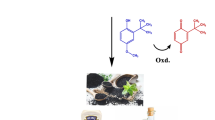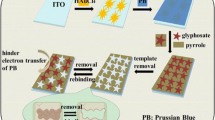Abstract
The authors describe a voltammetric sensor for trace analysis of streptomycin (STR). It is based on the use of a glassy carbon electrode that was modified with a film of STR-imprinted poly(pyrrole-3-carboxy acid) (PPy3C) on electrochemically reduced graphene oxide (ERGO). ERGO was first deposited on the surface of GCE by electro-reduction, this followed by deposition of a film of STR-imprinted PPy3C. The morphologies and properties of the sensor were characterized by scanning electron microscopy, cyclic voltammetry, and differential pulse voltammetry. Under optimized conditions, the sensor for STR displays two linear ranges that cover the 2 to 80, and the 80 to 1000 nM concentration range. Other features include a 0.5 nM limit of detection, good molecular recognition, and reliable practicability. Results indicate that the method provides a promising biomimetic platform for the determination of STR in food such as porcine kidney and honey.

A voltammetric sensor for trace analysis of streptomycin (STR) is described. It is based on the use of a glassy carbon electrode (GCE) that was modified with a film of STR-imprinted poly(pyrrole-3-carboxy acid) (PPy3C) on electrochemically reduced graphene oxide (ERGO).






Similar content being viewed by others
References
Vinas P, Balsalobre N, Hernandez-Cordoba M (2007) Liquid chromatography on an amide stationary phase with post-column derivatization and fluorimetric detection for the determination of streptomycin and dihydrostreptomycin in foods. Talanta 72:808–812
Baxter GA, Ferguson JP, O'Conno MC, Elliott CT (2001) Detection of streptomycin residues in whole milk using an optical Immunobiosensor. J Agric Food Chem 49:3204–3207
Farouk F, Azzazy HM, Niessen WM (2015) Challenges in the determination of aminoglycoside antibiotics, a review. Anal Chim Acta 890:21–43
Wassenaar TM (2005) Use of antimicrobial agents in veterinary medicine and implications for human health. Crit Rev Microbiol 31:155–169
REGULATION, H. A. T (1990) Council regulation (EEC) no 2377/90 of 26 June 1990 laying down a community procedure for the establishment of maximum residue limits of veterinary medicinal products in foodstuffs of animal origin. Official J L 224:0001–0008
Granja RH, Nino AM, Zucchetti RA, Nino RE, Patel R, Salerno AG (2009) Determination of streptomycin residues in honey by liquid chromatography-tandem mass spectrometry. Anal Chim Acta 637:64–67
Martina Preu MP (1999) Development and optimisation of a new derivatisation procedure for gas chromatographic–mass spectrometric analysis of dihydrostreptomycin comparison of multivariate and step-by-step optimisation procedures. J Chromatogr A 840:81–91
Gremilogianni AM, Megoulas NC, Koupparis MA (2010) Hydrophilic interaction vs ion pair liquid chromatography for the determination of streptomycin and dihydrostreptomycin residues in milk based on mass spectrometric detection. J Chromatogr A 1217:6646–6651
Hsiao YM, Ko JL, Lo CC (2001) Determination of tetracycline and streptomycin in mixed fungicide products by capillary zone electrophoresis. J Agric Food Chem 49:1669–1674
Currie D, Lynas L, Kennedy DG, McCaughey WJ (1998) Evaluation of a modified EC four plate method to detect antimicrobial drugs. Food Addit Contam 15:651–660
Wutz K, Niessner R, Seidel M (2011) Simultaneous determination of four different antibiotic residues in honey by chemiluminescence multianalyte chip immunoassays. Microchim Acta 173:1–9
Rebe Raz S, Bremer MGEG, Haasnoot W, Norde W (2009) Label-free and multiplex detection of antibiotic residues in milk using imaging surface Plasmon resonance-based Immunosensor. Anal Chem 81:7743–7749
Taghdisi SM, Danesh NM, Nameghi MA, Ramezani M, Abnous K (2016) A label-free fluorescent aptasensor for selective and sensitive detection of streptomycin in milk and blood serum. Food Chem 203:145–149
Que X, Liu B, Fu L, Zhuang J, Chen G, Tang D (2013) Molecular imprint for electrochemical detection of streptomycin residues using enzyme signal amplification. Electroanalysis 25:531–537
Soheili V, Taghdisi SM, Khayyat MH, Bazzaz BSF, Ramezani M, Abnous K (2016) Colorimetric and ratiometric aggregation assay for streptomycin using gold nanoparticles and a new and highly specific aptamer. Microchim Acta 183:1687–1697
Mishra GK, Sharma A, Bhand S (2015) Ultrasensitive detection of streptomycin using flow injection analysis-electrochemical quartz crystal nanobalance (FIA-EQCN) biosensor. Biosens Bioelectron 67:532–539
Emrani AS, Danesh NM, Lavaee P, Ramezani M, Abnous K, Taghdisi SM (2016) Colorimetric and fluorescence quenching aptasensors for detection of streptomycin in blood serum and milk based on double-stranded DNA and gold nanoparticles. Food Chem 190:115–121
Mohammad Danesh N, Ramezani M, Sarreshtehdar Emrani A, Abnous K, Taghdisi SM (2016) A novel electrochemical aptasensor based on arch-shape structure of aptamer-complimentary strand conjugate and exonuclease I for sensitive detection of streptomycin. Biosens Bioelectron 75:123–128
Zhang Z, Yang X, Zhang H, Zhang M, Luo L, Hu Y, Yao S (2011) Novel molecularly imprinted polymers based on multi-walled carbon nanotubes with binary functional monomer for the solid-phase extraction of erythromycin from chicken muscle. J Chromatogr B 879:1617–1624
Zhao YG, Zhou LX, Pan SD, Zhan PP, Chen XH, Jin MC (2014) Fast determination of 22 sulfonamides from chicken breast muscle using core–shell nanoring amino-functionalized superparamagnetic molecularly imprinted polymer followed by liquid chromatography-tandem mass spectrometry. J Chromatogr A 1345:17–28
Yin J, Cui Y, Yang G, Wang H (2010) Molecularly imprinted nanotubes for enantioselective drug delivery and controlled release. Chem Commun 46:7688–7690
Orozco J, Cortés A, Cheng G, Sattayasamitsathit S, Gao W, Feng X, Shen Y, Wang J (2013) Molecularly imprinted polymer-based catalytic Micromotors for selective protein transport. J Am Chem Soc 135:5336–5339
Martín-Esteban A (2013) Molecularly-imprinted polymers as a versatile, highly selective tool in sample preparation. TrAC Trends Anal Chem 45:169–181
Holthoff EL, Bright FV (2007) Molecularly templated materials in chemical sensing. Anal Chim Acta 594:147–161
Afkhami A, Ghaedi H, Madrakian T, Ahmadi M, Mahmood-Kashani H (2013) Fabrication of a new electrochemical sensor based on a new nano-molecularly imprinted polymer for highly selective and sensitive determination of tramadol in human urine samples. Biosens Bioelectron 44:34–40
Xue JQ, Li DW, Qu LL, Long YT (2013) Surface-imprinted core-shell Au nanoparticles for selective detection of bisphenol a based on surface-enhanced Raman scattering. Anal Chim Acta 777:57–62
Ramanavičius A, Ramanavičienė A, Malinauskas A (2006) Electrochemical sensors based on conducting polymer-polypyrrole. Electrochim Acta 51:6025–6037
Özcan A, İlkbaş S (2015) Poly(pyrrole-3-carboxylic acid)-modified pencil graphite electrode for the determination of serotonin in biological samples by adsorptive stripping voltammetry. Sensors Actuators B Chem 215:518–524
Yoon H, Kim J-H, Lee N, Kim B-G, Jang J (2008) A novel sensor platform based on aptamer-conjugated polypyrrole nanotubes for label-free electrochemical protein detection. Chembiochem 9:634–641
Janmanee R, Baba A, Phanichphant S, Sriwichai S, Shinbo K, Kato K, Kaneko F (2012) In situ electrochemical-transmission surface Plasmon resonance spectroscopy for poly(pyrrole-3-carboxylic acid) thin-film-based biosensor applications. ACS Appl Mater Interfaces 4:4270–4275
Dai H, Xiao D, He H, Li H, Yuan D, Zhang C (2015) Synthesis and analytical applications of molecularly imprinted polymers on the surface of carbon nanotubes: a review. Microchim Acta 182:893–908
Wang X, Dong J, Ming H, Ai S (2013) Sensing of glycoprotein via a biomimetic sensor based on molecularly imprinted polymers and graphene-Au nanoparticles. Analyst 138:1219–1225
Kong L, Jiang X, Zeng Y, Zhou T, Shi G (2013) Molecularly imprinted sensor based on electropolmerized poly(o-phenylenediamine) membranes at reduced graphene oxide modified electrode for imidacloprid determination. Sensors Actuators B Chem 185:424–431
da Silva H, Pacheco JG, McS Magalhães J, Viswanathan S, Delerue-Matos C (2014) MIP-graphene-modified glassy carbon electrode for the determination of trimethoprim. Biosens Bioelectron 52:56–61
Hummers WS, Offeman RE (1958) Preparation of graphitic oxide. J Am Chem Soc 80:1339–1339
Acknowledgements
This work was supported by the National Science Foundation of China (51662014 and 31660492), Postdoctoral Science Foundation of China (2015 M571987), Jiangxi Provincial Department of Education (GJJ150428, GJJ13259). Special Funds for Jiangxi Province Postdoctoral Research Funds (2015KY44), the authors also gratefully acknowledge the financial support of this work by Scientific Research Foundation for Doctor.
Author information
Authors and Affiliations
Corresponding author
Ethics declarations
The authors declare that they have no competing interests.
Electronic supplementary material
ESM 1
(DOC 199 kb)
Rights and permissions
About this article
Cite this article
Wen, Y., Liao, X., Deng, C. et al. Imprinted voltammetric streptomycin sensor based on a glassy carbon electrode modified with electropolymerized poly(pyrrole-3-carboxy acid) and electrochemically reduced graphene oxide. Microchim Acta 184, 935–941 (2017). https://doi.org/10.1007/s00604-017-2089-3
Received:
Accepted:
Published:
Issue Date:
DOI: https://doi.org/10.1007/s00604-017-2089-3




